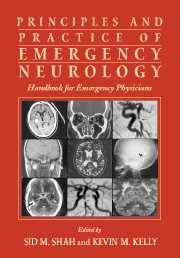Book contents
- Frontmatter
- Contents
- Preface
- Contributors
- SECTION I NEUROLOGICAL EXAMINATION AND NEURODIAGNOSTIC TESTING
- 1 Neurological Examination
- 2 Neuroradiology
- 3 Electroencephalography
- 4 Lumbar Puncture
- SECTION II COMMON NEUROLOGICAL PRESENTATIONS
- SECTION III SPECIFIC NEUROLOGICAL CONDITIONS
- SECTION IV NEUROLOGICAL TRAUMA
- SECTION V PEDIATRIC NEUROLOGICAL EMERGENCIES
- SECTION VI PREGNANCY-RELATED NEUROLOGICAL EMERGENCIES
- SECTION VII NEUROTOXICOLOGY
- SECTION VIII BRAIN DEATH
- Index
- References
2 - Neuroradiology
from SECTION I - NEUROLOGICAL EXAMINATION AND NEURODIAGNOSTIC TESTING
Published online by Cambridge University Press: 06 August 2009
- Frontmatter
- Contents
- Preface
- Contributors
- SECTION I NEUROLOGICAL EXAMINATION AND NEURODIAGNOSTIC TESTING
- 1 Neurological Examination
- 2 Neuroradiology
- 3 Electroencephalography
- 4 Lumbar Puncture
- SECTION II COMMON NEUROLOGICAL PRESENTATIONS
- SECTION III SPECIFIC NEUROLOGICAL CONDITIONS
- SECTION IV NEUROLOGICAL TRAUMA
- SECTION V PEDIATRIC NEUROLOGICAL EMERGENCIES
- SECTION VI PREGNANCY-RELATED NEUROLOGICAL EMERGENCIES
- SECTION VII NEUROTOXICOLOGY
- SECTION VIII BRAIN DEATH
- Index
- References
Summary
- Type
- Chapter
- Information
- Principles and Practice of Emergency NeurologyHandbook for Emergency Physicians, pp. 12 - 29Publisher: Cambridge University PressPrint publication year: 2003

